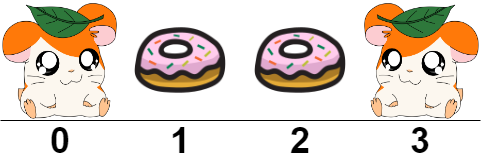- {x}
- Two Furthest Houses With Different Colors
- Watering Plants
- Range Frequency Queries
- Sum of k-Mirror Numbers
- The Number of Rich Customers
- Substrings That Begin and End With the Same Letter
- Drop Type 1 Orders for Customers With Type 0 Orders
- Count Common Words With One Occurrence
- Minimum Number of Food Buckets to Feed the Hamsters
- Minimum Cost Homecoming of a Robot in a Grid
- Count Fertile Pyramids in a Land
- Find Target Indices After Sorting Array
- K Radius Subarray Averages
- Removing Minimum and Maximum From Array
- Find All People With Secret
- Minimum Cost to Reach City With Discounts
- Finding 3-Digit Even Numbers
- Read More...

Minimum Number of Food Buckets to Feed the Hamsters
You are given a 0-indexed string hamsters where hamsters[i] is either:
'H'indicating that there is a hamster at indexi, or'.'indicating that indexiis empty.
You will add some number of food buckets at the empty indices in order to feed the hamsters. A hamster can be fed if there is at least one food bucket to its left or to its right. More formally, a hamster at index i can be fed if you place a food bucket at index i - 1 and/or at index i + 1.
Return the minimum number of food buckets you should place at empty indices to feed all the hamsters or -1 if it is impossible to feed all of them.
Example 1:

Input: hamsters = "H..H" Output: 2 Explanation: We place two food buckets at indices 1 and 2. It can be shown that if we place only one food bucket, one of the hamsters will not be fed.
Example 2:

Input: hamsters = ".H.H." Output: 1 Explanation: We place one food bucket at index 2.
Example 3:

Input: hamsters = ".HHH." Output: -1 Explanation: If we place a food bucket at every empty index as shown, the hamster at index 2 will not be able to eat.
Constraints:
1 <= hamsters.length <= 105hamsters[i]is either'H'or'.'.
Solution Explanation
This problem asks for the minimum number of food buckets needed to feed all hamsters, given a string representing the arrangement of hamsters ('H') and empty spaces ('.'). A hamster can be fed if there's a bucket to its left or right. The solution uses a greedy approach.
Greedy Approach:
The core idea is to iterate through the hamsters string. When we encounter a hamster ('H'), we try to place a bucket in the most efficient way possible:
-
Check the right: If there's an empty space to the right (
.) of the hamster, place a bucket there. This allows us to potentially feed this hamster and possibly the next one with a single bucket. Move the indexiforward by 2 to skip over both the hamster and the placed bucket. -
Check the left: If there's no empty space to the right, but there's an empty space to the left, place the bucket to the left.
-
Impossible case: If neither to the left nor right is empty, it's impossible to feed this hamster, so return
-1.
Time Complexity Analysis:
The solution iterates through the string once. Therefore, the time complexity is O(n), where n is the length of the hamsters string.
Space Complexity Analysis:
The solution uses only a constant amount of extra space. Therefore, the space complexity is O(1).
Code Explanation (Python)
class Solution:
def minimumBuckets(self, street: str) -> int:
ans = 0
i, n = 0, len(street)
while i < n:
if street[i] == 'H':
if i + 1 < n and street[i + 1] == '.': #Check right
i += 2
ans += 1
elif i and street[i - 1] == '.': #Check Left
ans += 1
else:
return -1 #Impossible case
i += 1
return ans
The Python code directly implements the greedy strategy described above. It iterates through the street string. If it finds a hamster:
- It checks if a bucket can be placed to the right. If so, it increments the bucket count (
ans) and moves the indexiforward by two. - Otherwise, it checks to the left. If possible, it places a bucket to the left, increments
ans. - If neither is possible, it returns
-1.
The other languages (Java, C++, Go) follow the same logic, just with the syntactic differences of those languages. The core algorithm and complexity analysis remain the same.